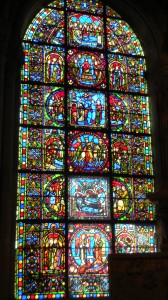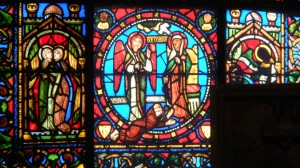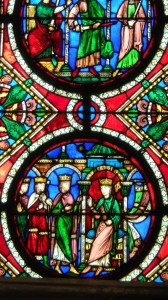Nothing like the church of St. Denis’ choir had been created before, and it’s one of the most influential works of art in world history. Gothic style was born at the church’s main entrance, but it attained full glory here.
The choir’s creator, Abbot Suger, wanted light on the altar. Mission accomplished, and a whole lot more.
An ambulatory surrounds the choir, and 7 chapels project from a semi-circle that surrounds it. Each chapel has 2 stained-glass window panels. So the east end of the church is surrounded by a wall of 14 stained glass window panels that bathe the choir in light reflected from these illustrations of Biblical themes. From the solid Romanesque wall, to reflections of divine light.
Both of the above photos are of the panel that illustrates the Childhood of Christ. The one immediately above is of the bottom scene, the Annunciation to Mary of Jesus’ future birth. These images are not only a lot prettier than a wall, they open the perspective–in two directions at the same time.
On one hand, the perspective goes metaphysical–into neo-Platonistic ideas that light was an early emanation of God. And this idea is fused with Biblical stories, and the centrality of Jesus in our life. The procession through the church that began with the sculpture of the Last Judgment and the bronze doors’ friezes of Christ’s Passion and Resurrection culminates here, where the windows immerse the altar in the prime aspects of creation. Jesus’ body and blood become spirit in the Mass, and this transformation is bathed in divine images. Our salvation is made real. But–
Perspectives also advanced in worldly directions. Above is a scene from the panel of the Life of Christ. Here’s Herod’s court portrayed like a 12th century French court. You can almost imagine King Louis the Fat chomping on a drumstick.
Nobody in any culture had done this. Nobody had created a wall of glass and surrounded a large open space with it. Angkor Wat is jaw-dropping, but the Khmers couldn’t build stone arches, much less entire glass walls. Thai art is some of the world’s most enchanting, but only the medieval West could surround a whole space with windows and immerse it in reflections from their most meaningful images. How did they do it?
Above, you can see the ambulatory around the altar. The ribbed vaulting in the ceiling was mixed with pointed arches and narrow columns. Many churches in Normandy, England and Germany had been built with ribbed vaulting around 1100, but its mixture with pointed arches and thin columns was the most efficient at distributing stress. Most of the space could thus be used for the surrounding windows.
Abbot Suger was elated. He wrote about creating this choir. On one hand he said, “–bright is that which is brightly coupled with the bright.” We can understand why he used spiritual language to describe it. But practically in the same breath, he wrote, “It was I, Suger, the leader while it was built.” In other words, God’s glory on earth; it was built by THIS DUDE!
But who wouldn’t have been proud. Suger sounds like a guy I’d enjoy eating dinner with. He advanced both idioms–spiritual and worldly. Medieval Europe would build on both at the same time, and soar to become one of the most interesting civilizations in world history.
This series of posts began with Gothic Style Is Born, Part One.





{ 1 comment }
Beautiful post. There are so many lovely abbeys in Normandy. Like this ruined one http://caroleschatter.blogspot.co.nz/2011/11/abbaye-de-hambye-lower-normandy-france.html
Comments on this entry are closed.